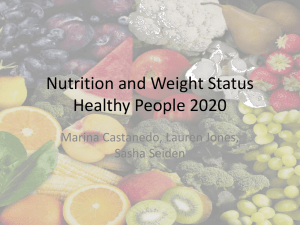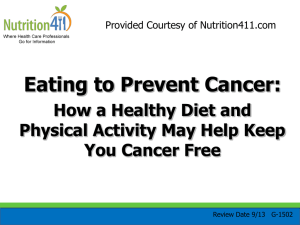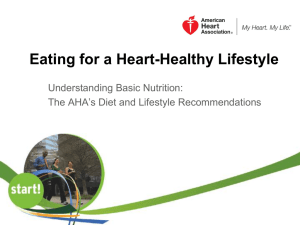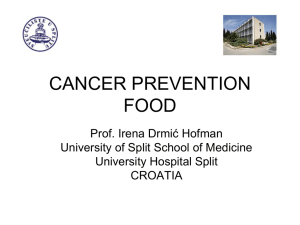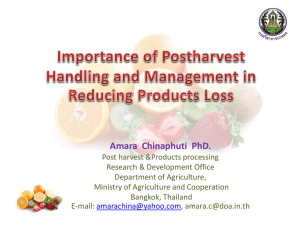Nutrition in Cancer Prevention
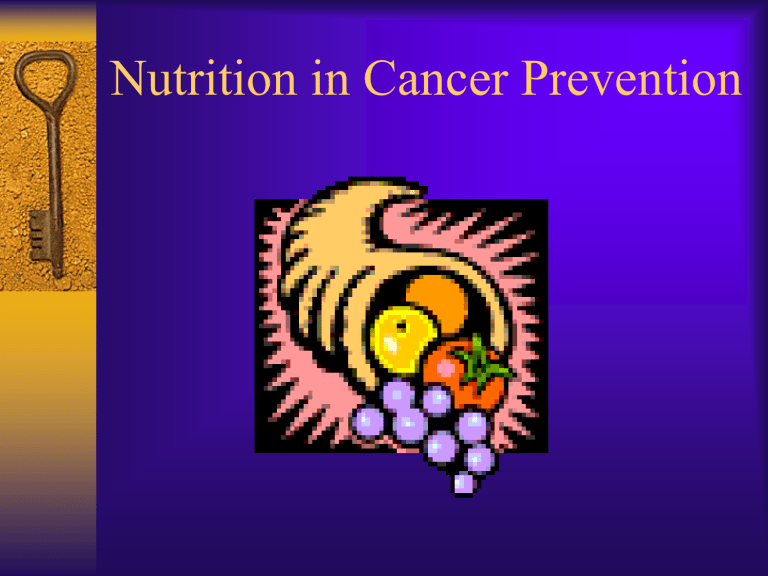
Nutrition in Cancer Prevention
Nutrition in Cancer Prevention
Because carcinogenesis occurs over years, most data linking diet and cancer is epidemiological (case control, cohort, or cross-sectional studies)
It is estimated that one third of the cancer deaths each year in the US can be attributed to nutrition and other lifestyle factors (not including smoking)
Types of Epidemiologic Studies of Cancer
Case Control Studies
The diets of individuals with cancer are compared with those of cancer-free controls matched for age, sex, and other key factors.
Cohort Studies
The diets of different groups of subjects are determined before cancer onset, and the incidences of developing cancers in each group are compared.
Cross-sectional Studies
The diets of different groups of subjects are compared, using the same measures at a single point in time.
Nutrition in the Etiology of
Cancer– cont’d
Complex relationship
Dietary carcinogens: naturally occurring and added in food preparation and preservation
Inhibitors of carcinogenesis: antioxidants, phytochemicals
Enhancers of carcinogenesis
Latency period between initiation and promotion
Energy Intake, Body Weight,
Obesity, and Physical Activity
Energy restriction inhibits cancer and extends life span in animals
Positive associations between overweight and cancers of the breast, endometrium, kidney, colon, prostate, and others
Overweight increases risk of cancer recurrence and decreases survival
Physical activity is inversely associated with cancer
Nutrition and Cancer Etiology
Fat
Protein
Soy and phytoestrogens
Carbohydrates: fiber, sugars, and glycemic index
Fruits and vegetables
Nonnutritive sweeteners
Nutrition and Cancer Etiology– cont’d
Alcohol
Coffee and tea
Methods of food preparation and preservation
Cancer chemoprevention
Cancer prevention recommendations: nutrition and physical activity
Nutrition and physical activity recommendations for cancer survivors
Color Code System of
Vegetables and Fruits
Color
Red
Phytochemical
Lycopene
Red/purple
Orange
Orange/yellow
Yellow/green
Green
White/green
Anthocyanins, polyphenols
α-, β-carotene
β-cryptoxanthin, flavonoids
Lutein, zeaxanthin
Sulforaphanes, indoles
Allyl sulphides
Vegetables and Fruits
Tomatoes and tomato products, pink grapefruit, watermelon
Berries, grapes, red wine, prunes
Carrots, mangoes, pumpkin
Cantaloupe, peaches, oranges, papaya, nectarines
Spinach, avocado, honeydew, collard and turnip greens
Cabbage, broccoli,
Brussels sprouts, cauliflower
Leeks, onion, garlic, chives
Data from Heber D: Vegetables, fruits and phytoestrogens in the prevention of diseases, F Postgrad Med 50:145, 2004.
Guidelines for Cancer Prevention
1.
Choose a diet rich in a variety of plant-based foods.
2.
Eat plenty of vegetables and fruits.
3.
Maintain a healthy weight and be physically active.
4.
Drink alcohol only in moderation, if at all.
5.
Select foods low in fat and salt.
6.
Prepare and store food safely.
And always remember . . . Do not use tobacco in any form.
From American Institute for Cancer Research: Simple steps to prevent cancer, Washington, DC, 2000, AICR.
Nutrition in Cancer Prevention
Diets contain both inhibitors and enhancers of carcinogenesis
Animal studies also test the effect of food and nutrition on cancer and provide guidance for epidemiological studies
Fat
High intake of total and saturated fat is associated with increased risk of breast, colon, lung and prostate cancers
High fat diets are associated with obesity, which is linked with cancer of the colon, rectum, esophagus, gall bladder, breast, endometrium, pancreas, and kidney
Animal fat (from meat and dairy) was associated with increased risk of breast cancer in the Nurses
Health study and others
Higher omega-3 vs omega 6 may reduce risk of breast cancer
Low fat diet (<20% fat) may reduce risk of recurrence of breast cancer
Energy Intake and Physical
Activity
Total energy intake is strongly associated with breast cancer in postmenopausal women
Physical activity may have a protective effect
Women who spent an average 3.8 hours per week in physical activities had lower risk of colon, reproductive cancers
Obesity is a Risk Factor for:
Breast cancer
(among postmenopausal women)
Gallbladder
Pancreas
Kidney
Colon
Endometrium
Is also a risk factor for cancer recurrence
Esophagus
Protein
Difficult to isolate effects of protein, since ↑ protein diets are ↑ in fat and ↓ in fiber
Low protein diets seem to reduce the risk of cancer, while risk is increased by very high protein intakes
Increased meat intake is associated with increased risk of colon cancer and advanced prostate cancer
Fiber
Observational studies and case control studies indicate that fiber-rich diets are associated with a protective effect in colon cancer
Higher intakes of vegetables were inversely associated with colon cancer risk in one study
But high fiber diets also tend to be lower in meat, fat, and refined carbohydrates
Fiber
Two intervention trials evaluating the effect of fiber on polyp and adenoma recurrence failed to show an effect of high fiber vs low fiber diets
Recommendation is to eat high fiber foods despite lack of conclusive evidence re cancer
Carbohydrate and Glycemic Index
High glycemic-index diet associated with increased risk of cancers including ovarian, endometrial, breast, colorectal, pancreas, and lung
Limit processed foods and refined sugars and emphasize whole grains and low GI foods
Fruits and Vegetables
Fruits and vegetables found to be associated with lower risk in 128 of 156 dietary studies
Increased consumption of fruits and vegetables is associated with lower risk of cancers of the oral cavity, esophagus, stomach, colon, rectum, and bladder
Evidence less strong for hormone-related cancers such as breast and prostate cancer
Fruits and Vegetables
People who develop cancer tend to have low intakes of
Raw and fresh vegetables
Leafy green vegetables
Lettuce, carrots, raw and fresh fruit
Cruciferous (cabbage family) vegetables
Flavenoids and lignans (soy, grains, vegetables) are associated with lower risk of sex hormonerelated cancers
Fruits and Vegetables
Low in energy, good sources of fiber, vitamins, minerals
Good sources of antioxidants (vitamins C,
E, selenium, phytochemicals such as carotenoids, flavonoids, plant sterols, allium compounds, indoles, phenols, terpenes
Do not yet know what is the protective agent(s) so best to use food sources
Plant based foods may prevent cancer by
Inhibiting hormone-dependent steps in tumor formation and protecting genetic material from carcinogenic agents
Suppressing free radical production
Serving as bulking agents to dilute carcinogens and decrease gastrointestinal transit time
Stimulators of physiologically active and anti-cancer enzymes
Mobley C. Nutrition and cancer prevention. In McCallum and Polisena, The Clinical
Guide to Oncology Nutrition. Oncology Nutrition Dietetic Practice Group, 2000.
Cancer Chemoprevention Studies
ß-carotene supplementation in Finnish smokers was associated with a 16% higher incidence of lung cancer
Heavy alcohol intake seemed to enhance negative effects
However, diet studies suggest that high fruit and vegetable consumption, particularly carotenoids, tomatoes, and tomato-based products may reduce risk of lung cancer
Supplementation in Persons at High Risk for Esophageal-Gastric Cancer in China
Study in area of China with diet low in micronutrients and very high risk of esophageal and gastric cancer
ß-carotene, vitamin E, and selenium at 5X the RDA was associated with significantly lower mortality from all cancers
Calcium and Cancer Risk
Several studies suggest that foods high in calcium may reduce the risk for colorectal cancer and that calcium supplements may reduce the formation of colorectal polyps
However, there is evidence that high calcium intake, especially supplements, is associated with increased risk of prostate cancer
Bottom line: get calcium through food sources
Lycopene and Cancer Risk
Lycopene is a red-orange carotenoid found in tomatoes and tomato-based foods
Several studies show that consuming tomato products reduces the risk of some cancers, but unclear whether lycopene is responsible
Absorption of lycopene is enhanced when lycopene-containing vegetables are cooked and eaten with fat
No evidence that supplements are safe and effective in cancer prevention.
Source: American Cancer Society, accessed 2005
Preserved Meats and Cancer Risk
Some studies link eating large amounts of preserved meat to increased risk of colorectal and stomach cancers
May or may not be due to nitrites
Nitrites can be converted in the stomach to carcinogenic nitrosamines, which may increase the risk of stomach cancer
Vegetables and fruit retard the conversion of nitrites to nitrosamines
Cooked Meat and Cancer Risk
Frying, broiling, and grilling meats at high temperatures creates chemicals that might increase cancer risk (cause cancer in animals)
Use techniques such as braising, steaming, poaching, stewing and microwaving
Soy and Cancer Risk
No evidence shows soy supplements reduce cancer risk
Soy contains several phytochemicals
(phytoestrogens) which have weak estrogen activity and appear to protect against hormonedependent cancers in animal studies
High doses of soy may increase the risk of estrogen-responsive cancers, such as breast or endometrial cancers in certain women
Breast cancer survivors should consume only moderate amounts
Alcohol
Alcohol associated with carcinogenesis in cancers of the mouth, pharynx, larynx, esophagus, lung, colon, rectum, liver and breast (USDHHS, 2000)
Appears to act synergistically with tobacco
Malnutrition associated with alcoholism may also be implicated
Coffee and Tea
Coffee has been investigated as a possible risk factor for a variety of cancers, but does not appear to be associated with increased cancer
Regular drinking of green tea and other sources of polyphenols may reduce the risk of stomach cancer
Consumption of very hot drinks may increase the risk of esophageal cancer
Artificial Sweeteners
Cyclamate banned as food additive in US in
1969 and saccharine in 1977 after being associated with bladder cancer in mice
Under public pressure, saccharine returned to the market; it was reviewed and taken off the list of potential carcinogens in 2000
Aspartame: no evidence implicating it in increased cancer risk
Artifical Sweeteners
Five artificial sweeteners on the market:
Acesulfame-K
Aspartame
Neotame
Saccharine
Sucralose
Hyperinsulinemia and Cancer
Increased body mass index may promote hyperinsulinemia and metabolic syndrome
Insulin resistance/hyperinsulinemia, higher estrogen levels, and insulin-like growth factor I may act synergistically to promote tumor growth, particularly mammary tumors.
Food Safety and Cancer
Naturally occurring carcinogens (aflatoxins in peanuts, safrol in plant oils, tannins in grains and grapes, benzopyrene formed by smoking meat and fish)
Naturally found in plant foods like celery, parsley, figs, mustard, pepper, citrus oils
Pesticides
Food Safety and Cancer
Choose in-season, locally grown produce
Use proper food storage to prevent growth of fungal carcinogens
Rinse fruits and vegetables and remove outer leaves before eating
Marinate protein foods to decrease cooking time
Use cooking methods to avoid contact of foods and food drippings with flames
Use lower cooking temperatures with protein foods
Mobley C. Nutrition and cancer prevention. In McCallum and Polisena, The
Clinical Guide to Oncology Nutrition. Oncology Nutrition Dietetic Practice Group,
2000
AICR Diet and Health Guidelines for Cancer Prevention
Choose a diet rich in a variety of plantbased foods
Eat plenty of vegetables and fruits.
Maintain a healthy weight and be physically active.
Drink alcohol only in moderation, if at all.
Select foods low in fat and salt.
Prepare and store food safely.
American Cancer Society Guide to
Nutrition and Activity
Eat a variety of healthful foods, with an emphasis on plant sources.
Eat five or more servings of a variety of vegetables and fruits each day.
Include vegetables and fruits at every meal and for snacks.
Eat a variety of vegetables and fruits.
Limit French fries, snack chips, and other fried vegetable products.
Choose 100% juice if you drink fruit or vegetable juices .
American Cancer Society Guide to
Nutrition and Activity
Choose whole grains in preference to processed
(refined) grains and sugars.
Choose whole grain rice, bread, pasta, and cereals.
Limit consumption of refined carbohydrates, including pastries, sweetened cereals, soft drinks, and sugars.
American Cancer Society Guide to
Nutrition and Activity
Limit consumption of red meats, especially those high in fat and processed.
Choose fish, poultry, or beans as an alternative to beef, pork, and lamb.
When you eat meat, select lean cuts and smaller portions.
Prepare meat by baking, broiling, or poaching, rather than by frying or charbroiling.
American Cancer Society Guide to
Nutrition and Activity
Choose foods that help maintain a healthful weight.
When you eat away from home, choose food low in fat, calories, and sugar and avoid large portions.
Eat smaller portions of high-calorie foods. Be aware that
“low fat” or “fat free” does not mean “low calorie” and that low-fat cakes, cookies, and similar foods are often high in calories.
Substitute vegetables, fruits, and other low-calorie foods for calorie-dense foods such as French fries, cheeseburgers, pizza, ice cream, doughnuts, and other sweets.
Lifestyle Changes to Reduce Breast
Cancer Risk
Reducing alcohol consumption
Breastfeeding
Avoiding obesity
Being physically active
Source: American Cancer Society, accessed
2005
Lifestyle Change to Prevent Colon
Cancer
Increase your physical activity
Eat more vegetables and fruit
Limit intake of red meats
Avoid obesity
Avoid excess alcohol
Source: American Cancer Society, accessed 2005
Lifestyle Changes to Prevent Oral and Esophageal Cancers
The best advice to reduce the risk of oral and esophageal cancers is to:
Avoid all forms of tobacco
Restrict alcohol consumption
Avoid obesity
Lifestyle Changes to Prevent
Pancreatic Cancer
Avoid tobacco use
Maintain a healthful weight
Remain physically active
Eat five or more servings of vegetables and fruits each day
Source: American Cancer Society, accessed 2005
Lifestyle Changes to Prevent
Prostate Cancer
Limit intake of animal products, especially red meat and high-fat dairy products
Eat five or more servings of vegetables and fruits each day
Lifestyle Changes to Prevent
Stomach Cancer
Eat at least five servings of vegetables and fruits daily.
Stomach cancer rates are falling due to reduced infection with h. pylori
At Present, There Are No Nutritional
Risk Factors for
Brain Cancer
Leukemias
Ovarian cancer
Source: American Cancer Society, accessed
2005
Diet Recommendations for
Cancer Survivors
Cancer survivor may harbor undetected primary or
disseminated cancer cells
A “cured” cancer pt is at increased risk for other primary cancers in the same organ or other organs
General dietary guidelines are also appropriate for recovering cancer pts
Dietary regimens should a) avoid stimulating growth and spread of remaining tumor cells and b) provide maximum prevention against new primary tumors
Nixon DW. Nutrition during cancer recovery. In McCallum and Polisena, The Clinical
Guide to Oncology Nutrition. Chicago, The American Dietetic Association, 2000.
Recommendations for Cancer
Survivors
Limit total fat intake to 15-20% of total calories. Monounsaturated fats are preferred.
Aim for 10-12 daily servings of a variety of whole vegetables and fruits.
Consume 4-6 servings of whole grains daily. Breast cancer pts should eliminate or severely restrict alcohol intake
Dietary Recommendations for
Cancer Survivors
Consider a Vitamin E supplement of 200
IU/day to replace deficit from reduced fat intake
Standard dose multivit daily (not to exceed
100% RDA). This does not replace cancerfighting foods
Exercise moderately (30 minute daily walk, for example)
Maintain desirable body weight

